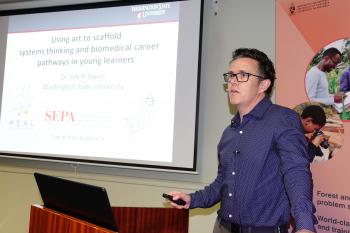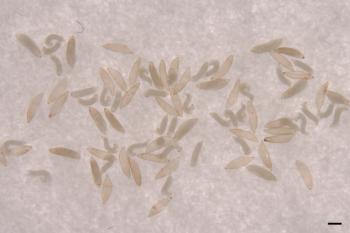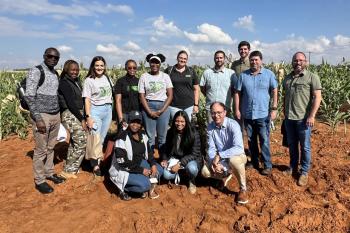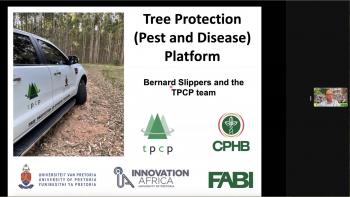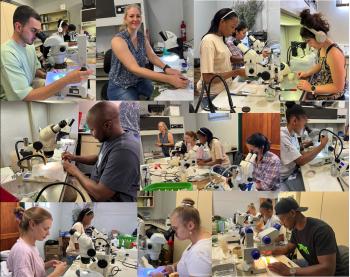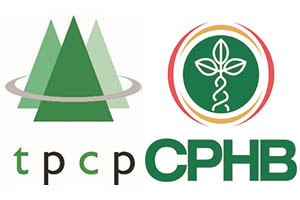Summary
Needle diseases of pines
Two potentially important diseases of pine needles are known in South Africa. These are Dothistroma needle blight caused by Dothistroma septosporum and Cercoseptoria needle blight caused by Cercoseptoria pini-densiflorae. In addition, Diplodia pinea can infect, kill and sporulate on pine needles. This fungus, however, usually infects shoots as discussed previously.
The primary needle pathogens of pines infect healthy, young foliage. Infections usually occur early in spring during wet, warm weather. After infection, symptoms may take a few days or a few months to appear. To recognise a primary needle disease, it is necessary to inspect the current year's needles at regular intervals. Needle pathogens usually infect most of the trees of a susceptible species in an area and are often most severe on younger trees and seedlings. In older plantations, a needle disease is often detected by inspecting natural regeneration.
Dothistroma needle blight can be identified by chlorotic bands on the older needles at the base of branches in the lower half of the tree. These yellow bands spread to cover the entire needle, which ultimately turns brown and is shed. As the disease develops, it spreads to the younger foliage at the branch tips and at a chronic stage the tree may be left only with tufts of current year needles. Groups of small black fruiting bodies of the fungus break through the epidermis of dead needles.
Cercoseptoria needle blight was first recognised in South Africa in the 1980's where it was found in the eastern Cape, mainly on P. radiata, and in the eastern Mpumalanga on P. patula. This disease can be very severe in nurseries and young plantations where seedlings of many pine species can be entirely defoliated. The fungus usually infects old foliage first but in severe cases young foliage can also be affected. The first symptoms of infection are light green bands on the needles, which then turn yellow, brown and finally a grey colour. Fruiting bodies can be seen on dead needles and are characteristically "brush-like" and gray in appearance.
There are a number of other fungi that occur on senescent pine needles in South Africa (Crous et al. 1990). These are often found on needles killed by some of the previously mentioned needle pathogens. Under certain conditions these fungi can be pathogenic and kill healthy needles. The two most common genera in this group are Lophodermium spp. and Cyclaneusma spp. Lophodermium spp. are easily recognised on dead needles by the very distinct, elongate, black fruiting structures which open by a longitudinal slit in the centre. Cyclaneusma minus also produces distinct fruiting structures on dead needles. This fungus causes the needles to break open on the surface in a double "trap-door" like pustule.
Leaf diseases of eucalypts
In recent years, considerable effort has been made to identify the most common eucalypt leaf-infecting fungi. This has resulted in the identification of a large number of fungi, ranging from virtually saprophytic to highly pathogenic. Of these the most common leaf pathogens include Teratosphaeria (Mycosphaerella) spp. (T. nubilosa is considered most common and important), Aulographina eucalypti, Kirramyces (Phaeophloeospora) epicoccoides, Sphaerotheca pannosa and Pseudocercospora eucalypti (Crous et al., 1989).
At present, only Teratosphaeria spp. are considered to be major pathogens of eucalypts in plantations. These fungi cause a disease commonly known as Mycosphaerella leaf blotch. This disease occurs on many eucalypt species but is most common and serious on E. nitens. Mycosphaerella leaf blotch is characterised by large necrotic lesions on juvenile leaves and the presence of small black pseudothecia (fruiting structures containing sexual spores) on these lesions.
Only juvenile leaves of E. nitens are susceptible to infection by Teratosphaeria spp. and, once trees produce adult leaves, they are no longer affected by this pathogen. Victoria provenances of E. nitens are highly susceptible and severe defoliation can prevent trees from reaching the adult leaf stage. In general, New South Wales provenances are relatively resistant to this disease. Certain provenances from this area are, however, beginning to show unacceptable levels of susceptibility to Mycosphaerella leaf blotch. In recent years, the disease has also begun to occur commonly on E. grandis and there are indications that the pathogen is adapting to this species.
Powdery mildew caused by Sphaerotheca pannosa is an important and damaging disease of eucalypts in seedling as well as vegetative propagation nurseries. It is also important on trees in clonal hedge banks. The disease can cause serious defoliation and even death of trees in these situations (Crous et al., 1989).
Leaf spot and blight cause by Quambalaria eucalypti is a sporadic problem in the Zululand region, especially in nurseries. Infection may result in shoot death and affects the production of cuttings from hedges. The disease is most common on E. grandis hybrid clones in Zululand, but has also been found on E. nitens in the Mpumalanga region of the country (Roux et al. 2006).
Leaf diseases of wattle
Only two diseases are known to affect the leaves of wattle trees in South African plantations. These include rust caused by Uromyces alpinum and leaf spot caused by the Ascomycete, Camptomeris albizziae. Losses associated with these diseases are minimal. They do, however, appear to be associated with leaf drop, which can often be severe in autumn (Roux 2002).


